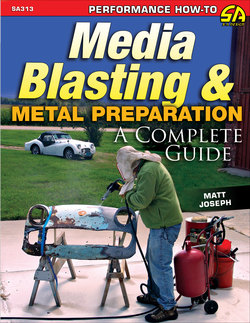Читать книгу Media Blasting & Metal Preparation - Matt Joseph - Страница 4
На сайте Литреса книга снята с продажи.
ОглавлениеTitle Page:
This is what the inside of a blast room looks like. The item under blast attack is too large to fit into a blast cabinet, which leaves an outside blasting or a blast room as the only options for blasting it. The operator is breathing outside air and is protected from blast media from head to toe.
Back Cover Photos
Top:
Soda blasting the flat back panel of this truck cab is a very safe way to remove the paint and any loose rust from it. Note the close blasting distance and very perpendicular blast angle. There isn’t much rust under the paint in this area, because the paint here is pretty sound.
Upper Middle:
These red- and green-handled metering/on-off valves control the flow of each of the two types of media in Eastwood’s Dual Blast system. You can make running adjustments as you blast. This is much less cumbersome than hauling two completely separate blast systems to your blast site and managing them.
Lower Middle:
For post-blasting preservation, you can apply After Blast with a plastic spray bottle. It should be allowed to sit for a short time and then wiped off. How long its protection from rust lasts depends on external factors such as temperature and humidity.
Bottom:
Removing paint and rust mechanically with a disc sander was the traditional way to strip panels. The poly disc, shown here, cuts reasonably quickly and reduces the chances of locally overheating metal. However, it cannot remove deep rust, such as the rust in the photograph, under and behind its leading edge.
DISTRIBUTION BY:
Europe
PGUK
63 Hatton Garden
London EC1N 8LE, England
Phone: 020 7061 1980 • Fax: 020 7242 3725
www.pguk.co.uk
Australia
Renniks Publications Ltd.
3/37-39 Green Street
Banksmeadow, NSW 2109, Australia
Phone: 2 9695 7055 • Fax: 2 9695 7355
www.renniks.com
